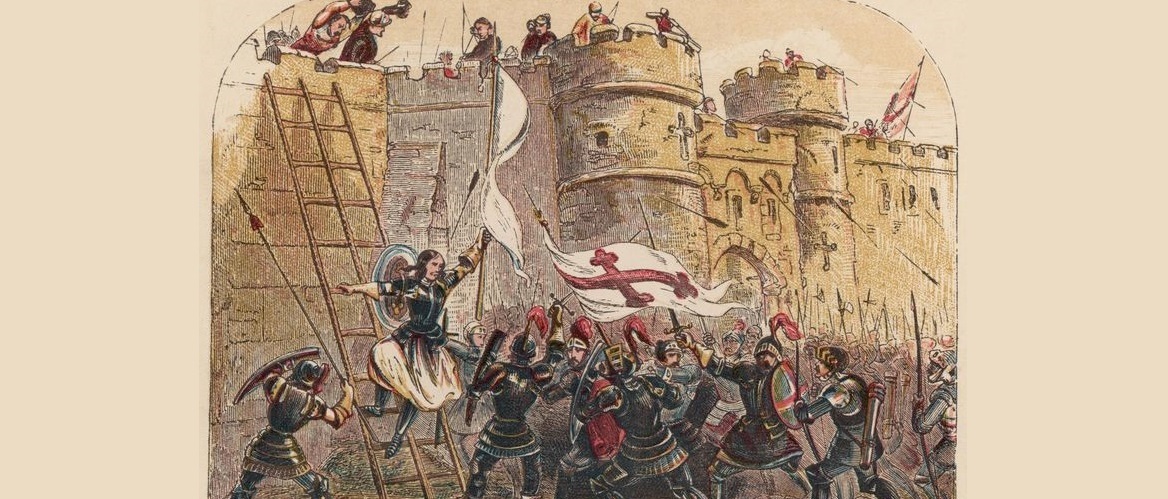Joan of Arc
Posted on 12th January 2021
Joan was born around 1412 in Domremy, France to her father Jacques, a farmer and her mother Isabelle; she was one of five children. They were a poor family and her father, as well as farming the land, earned extra money by working as a local village official.
The family home was deeply religious, and religion was Joan’s only education, like most peasant children at that time, she was not taught to read or write.
Joan was raised during a very unstable time for France and she was to witness many army raids and even the burning of her own village during her childhood.
It was around the age of twelve that Joan stated that she had experienced her first vision. In this and subsequent visions she stated that Saint Michael, Saint Catherine of Alexandria and Saint Margaret of Antioch instructed her to drive out the English and take back her homeland from English Rule. The saints asked Joan to bring the Dauphin Charles (heir apparent to the French throne) to Reims for his coronation.
Joan knew that as a peasant girl it would be difficult to get people to listen to her, but she was not deterred.
At the age of sixteen she travelled with a relative, Durand Lassois to the town of Vaucouleurs to petition the garrison commander Robert de Baudricourt for help in taking her to the French court at Chinon to see Charles, but Baudricourt did not take Joan seriously and refused to help.
Joan left, but then having gained support from local leaders she returned later that same year and asked Baudricourt again.
This time he agreed and provided her with an escort to the Royal Court at Chinon. For safety, Joan cut her hair short and wore men’s clothes for the eleven-day journey to Chinon.
After arriving at the Royal Court, Joan was granted an audience with Charles, the future King. Charles was suspicious of Joan and her claims, and subjected her to a commission of inquiry. He wished to know if she was of sound mind.
Following the inquiry Joan was given a horse and armour and granted permission to travel to Orleans; she arrived there on 29 April 1429.
Orleans was the last major city defending Charles’ territory, but it was now under siege by the English.
Joan, having been given control of an army, battled the English and freed the city of Orleans after eleven days.
She followed this with further success at the Battle of Jargeau on 12 June, Battle of Meung-sur-Loire on 15 June, Battle of Beaugency on 17 June and finally the Battle of Patay on 18 June.
The French army then marched towards Reims; little resistance was met until the army reached the town of Troyes. A siege took place which resulted in Troyes surrendering after four days.
The army arrived in Reims on 16 July 1429 and Charles’ coronation took place the following morning.
Joan now wanted to advance on Paris; many towns surrendered on the way, but Joan and her army were unable to take Paris.
In May 1430 Charles VII ordered Joan to confront the Anglo-Burgundians at Compiegne in northern France. While trying to defend the town, she was captured on 23 May and later sold to the English. After being moved many times, she was finally held in the city of Rouen; the stronghold of the Earl of Wessex.
During this time, Charles, the man Joan had so diligently followed made no attempt to have her rescued.
Joan was charged with witchcraft and heresy, and bought to trial on 13 January 1431. She was first summoned to appear before her judges on 21 February. At this time, she swore to tell the truth, but then also refused to divulge information about Charles, as these were his enemies.
Joan was imprisoned for months. Her early captors had been kind to her and treated her well, but after her continued attempts at escape she was treated more harshly, sometimes chained to a wooden block or put in irons.
After all the accusations laid against her, Joan was finally convicted of repeated wearing of men’s clothing. She was convicted of heresy and burned at the stake on 30 May 1431. She was around nineteen years old.
The Maid of Orleans was loved by her people and became a Patron Saint of France.
The Catholic Church canonised her a Saint in 1920.
Tagged as: Junior Middle Ages
Share this post:





